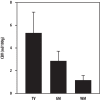Developing a Pipeline for Multiparametric MRI-Guided Radiation Therapy: Initial Results from a Phase II Clinical Trial in Newly Diagnosed Glioblastoma
- PMID: 30854449
- PMCID: PMC6403045
- DOI: 10.18383/j.tom.2018.00035
Developing a Pipeline for Multiparametric MRI-Guided Radiation Therapy: Initial Results from a Phase II Clinical Trial in Newly Diagnosed Glioblastoma
Abstract
Quantitative mapping of hyperperfused and hypercellular regions of glioblastoma has been proposed to improve definition of tumor regions at risk for local recurrence following conventional radiation therapy. As the processing of the multiparametric dynamic contrast-enhanced (DCE-) and diffusion-weighted (DW-) magnetic resonance imaging (MRI) data for delineation of these subvolumes requires additional steps that go beyond the standard practices of target definition, we sought to devise a workflow to support the timely planning and treatment of patients. A phase II study implementing a multiparametric imaging biomarker for tumor hyperperfusion and hypercellularity consisting of DCE-MRI and high b-value DW-MRI to guide intensified (75 Gy/30 fractions) radiation therapy (RT) in patients with newly diagnosed glioblastoma was launched. In this report, the workflow and the initial imaging outcomes of the first 12 patients are described. Among all the first 12 patients, treatment was initiated within 6 weeks of surgery and within 2 weeks of simulation. On average, the combined hypercellular volume and high cerebral blood volume/tumor perfusion volume were 1.8 times smaller than the T1 gadolinium abnormality and 10 times smaller than the FLAIR abnormality. Hypercellular volume and high cerebral blood volume/tumor perfusion volume each identified largely distinct regions and showed 57% overlap with the enhancing abnormality, and minimal-to-no extension outside of the FLAIR. These results show the feasibility of implementing a workflow for multiparametric magnetic resonance-guided radiation therapy into clinical trials with a coordinated multidisciplinary team, and the unique and complementary tumor subregions identified by the combination of high b-value DW-MRI and DCE-MRI.
Keywords: MRI; glioblastoma; multiparametric; pipeline; workflow.
Figures




Similar articles
-
The Brain Imaging Collaboration Suite (BrICS): A Cloud Platform for Integrating Whole-Brain Spectroscopic MRI into the Radiation Therapy Planning Workflow.Tomography. 2019 Mar;5(1):184-191. doi: 10.18383/j.tom.2018.00028. Tomography. 2019. PMID: 30854456 Free PMC article. Clinical Trial.
-
A Phase 2 Study of Multiparametric Magnetic Resonance Imaging-Guided High-Dose Response-Adaptive Radiation Therapy With Concurrent Temozolomide in Patients With Newly Diagnosed Glioblastoma: Results From an Interim Analysis.Int J Radiat Oncol Biol Phys. 2025 Jul 1;122(3):605-610. doi: 10.1016/j.ijrobp.2025.02.020. Epub 2025 Mar 8. Int J Radiat Oncol Biol Phys. 2025. PMID: 40058709 Clinical Trial.
-
Perfusion magnetic resonance imaging in contouring of glioblastoma patients: Preliminary experience from a single institution.J Cancer Res Ther. 2020 Oct-Dec;16(6):1488-1494. doi: 10.4103/jcrt.JCRT_1151_19. J Cancer Res Ther. 2020. PMID: 33342818
-
[Proton magnetic resonance spectroscopic imaging and other types of metabolic imaging for radiotherapy planning in adult and pediatric high-grade gliomas].Cancer Radiother. 2009 Oct;13(6-7):556-61. doi: 10.1016/j.canrad.2009.07.003. Epub 2009 Sep 18. Cancer Radiother. 2009. PMID: 19766525 Review. French.
-
[Use of the functional imaging modalities in radiation therapy treatment planning in patients with glioblastoma].Bull Cancer. 2005 Apr;92(4):333-42. Bull Cancer. 2005. PMID: 15888390 Review. French.
Cited by
-
Quantitative Imaging Enters the Clinical Arena: A Personal Viewpoint.Tomography. 2020 Jun;6(2):56-59. doi: 10.18383/j.tom.2020.00028. Tomography. 2020. PMID: 32548280 Free PMC article.
-
Advanced Imaging Techniques for Radiotherapy Planning of Gliomas.Cancers (Basel). 2021 Mar 3;13(5):1063. doi: 10.3390/cancers13051063. Cancers (Basel). 2021. PMID: 33802292 Free PMC article. Review.
-
Optimizing the radiotherapy treatment planning process for glioblastoma.Neurooncol Pract. 2022 Jun 21;9(5):351-353. doi: 10.1093/nop/npac051. eCollection 2022 Oct. Neurooncol Pract. 2022. PMID: 36134014 Free PMC article. No abstract available.
-
Evaluation of the Geometric and Dosimetric Accuracy of Synthetic Computed Tomography Images for Magnetic Resonance Imaging-only Stereotactic Radiosurgery.Cureus. 2019 Apr 8;11(4):e4404. doi: 10.7759/cureus.4404. Cureus. 2019. PMID: 31245194 Free PMC article.
-
MRI-Guided Radiation Therapy.Adv Oncol. 2021 May;1:29-39. doi: 10.1016/j.yao.2021.02.003. Epub 2021 May 19. Adv Oncol. 2021. PMID: 37064601 Free PMC article. No abstract available.
References
-
- Cao Y, Tsien CI, Nagesh V, Junck L, Ten Haken R, Ross BD, Chenevert TL, Lawrence TS. Survival prediction in high-grade gliomas by MRI perfusion before and during early stage of RT [corrected]. Int J Radiat Oncol Biol Phys. 2006;64:876–885. - PubMed
-
- Law M, Young RJ, Babb JS, Peccerelli N, Chheang S, Gruber ML, Miller DC, Golfinos JG, Zagzag D, Johnson G. Gliomas: predicting time to progression or survival with cerebral blood volume measurements at dynamic susceptibility-weighted contrast-enhanced perfusion MR imaging. Radiology. 2008;247:490–498. - PMC - PubMed
-
- Li X, Jin H, Lu Y, OH J, Chang S, Nelson SJ. Identification of MRI and 1H MRSI parameters that may predict survival for patients with malignant gliomas. NMR Biomed. 2004;17:10–20. - PubMed
Publication types
MeSH terms
Substances
Grants and funding
LinkOut - more resources
Full Text Sources
Medical
Research Materials

